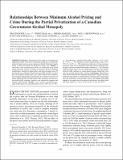Files in this item
Relationships between minimum alcohol pricing and crime during the partial privatization of a Canadian government alcohol monopoly
Item metadata
| dc.contributor.author | Stockwell, T. | |
| dc.contributor.author | Zhao, J. | |
| dc.contributor.author | Marzell, M. | |
| dc.contributor.author | Gruenewald, P. J. | |
| dc.contributor.author | Macdonald, S. | |
| dc.contributor.author | Ponicki, W. R. | |
| dc.contributor.author | Martin, G. | |
| dc.date.accessioned | 2016-11-18T00:33:51Z | |
| dc.date.available | 2016-11-18T00:33:51Z | |
| dc.date.issued | 2015-07 | |
| dc.identifier | 213557935 | |
| dc.identifier | 8b0f9a6a-8222-4892-a3bc-f09fd5aa3ac2 | |
| dc.identifier | 84939129969 | |
| dc.identifier | 000356911200017 | |
| dc.identifier.citation | Stockwell , T , Zhao , J , Marzell , M , Gruenewald , P J , Macdonald , S , Ponicki , W R & Martin , G 2015 , ' Relationships between minimum alcohol pricing and crime during the partial privatization of a Canadian government alcohol monopoly ' , Journal of Studies on Alcohol and Drugs , vol. 76 , no. 4 , pp. 628-634 . https://doi.org/10.15288/jsad.2015.76.628 | en |
| dc.identifier.issn | 1937-1888 | |
| dc.identifier.uri | https://hdl.handle.net/10023/9839 | |
| dc.description | Research and preparation for this article were supported by National Institute on Alcohol Abuse and Alcoholism Grants R21-AA019488 and P60-AA06282. | en |
| dc.description.abstract | Objective: The purpose of this study was to estimate the independent effects of increases in minimum alcohol prices and densities of private liquor stores on crime outcomes in British Columbia, Canada, during a partial privatization of off-premise liquor sales. Method: A time-series cross-sectional panel study was conducted using mixed model regression analysis to explore associations between minimum alcohol prices, densities of liquor outlets, and crime outcomes across 89 local health areas of British Columbia between 2002 and 2010. Archival data on minimum alcohol prices, per capita alcohol outlet densities, and ecological demographic characteristics were related to measures of crimes against persons, alcohol-related traffic violations, and non–alcohol- related traffic violations. Analyses were adjusted for temporal and regional autocorrelation. Results: A 10% increase in provincial minimum alcohol prices was associated with an 18.81% (95% CI: ±17.99%, p .05). Densities of private liquor stores were not significantly associated with alcohol involved traffic violations or crimes against persons, though they were with non–alcohol-related traffic violations. Conclusions: Reductions in crime events associated with minimum-alcohol-price changes were more substantial and specific to alcohol-related events than the countervailing increases in densities of private liquor stores. The findings lend further support to the application of minimum alcohol prices for public health and safety objectives. | |
| dc.format.extent | 7 | |
| dc.format.extent | 178872 | |
| dc.language.iso | eng | |
| dc.relation.ispartof | Journal of Studies on Alcohol and Drugs | en |
| dc.subject | RA0421 Public health. Hygiene. Preventive Medicine | en |
| dc.subject | 3rd-DAS | en |
| dc.subject | SDG 3 - Good Health and Well-being | en |
| dc.subject | SDG 16 - Peace, Justice and Strong Institutions | en |
| dc.subject.lcc | RA0421 | en |
| dc.title | Relationships between minimum alcohol pricing and crime during the partial privatization of a Canadian government alcohol monopoly | en |
| dc.type | Journal article | en |
| dc.contributor.institution | University of St Andrews. School of Medicine | en |
| dc.identifier.doi | 10.15288/jsad.2015.76.628 | |
| dc.description.status | Peer reviewed | en |
| dc.date.embargoedUntil | 2016-11-17 |
This item appears in the following Collection(s)
Items in the St Andrews Research Repository are protected by copyright, with all rights reserved, unless otherwise indicated.

